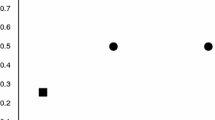Abstract
Previous covering models for emergency service consider all the calls to be of the same importance and impose the same waiting time constraints independently of the service's priority. This type of constraint is clearly inappropriate in many contexts. For example, in urban medical emergency services, calls that involve danger to human life deserve higher priority over calls for more routine incidents. A realistic model in such a context should allow prioritizing the calls for service. In this paper, a covering model which considers different priority levels is formulated and solved. The model heritages its formulation from previous research on Maximum Coverage Models and incorporates results from Queuing Theory, in particular Priority Queuing. The additional complexity incorporated in the model justifies the use of a heuristic procedure.







Similar content being viewed by others
References
Ball MO and Lin FL (1993). A reliability model applied to emergency service vehicle location. Opns Res 41: 18–36.
Batta R (1989). A queuing-location model with expected service time dependent queuing disciplines. Eur J Opl Res 39: 192–205.
Batta R and Mannur NR (1990). Covering-location models for emergency situations that require multiple response units. Mngt Sci 36: 16–23.
Batta R, Larson RC and Odoni AR (1988). A single-server priority queuing-location model. Networks 8: 87–103.
Berman O and Krass D (2002). Facility location problems with stochastic demands and congestion. Facility Location: Applications and Theory. Springer Verlag: Berlin.
Berman O and Vasudeva S (2000). Approximating performance measures for public services. Working Paper, Joseph L. Rotman School of Management, University of Toronto.
Berman O, Larson RC and Chiu SS (1985). Optimal server location on a network operating as an M/G/1 queue. Opns Res 12: 746–771.
Branas CC and Revelle CS (2001). An iterative switching heuristic to locate hospitals and helicopters. Socio-Econ Plann Sci 35: 11–30.
Brandeau ML and Chiu SS (1992). A center location problem with congestion. Ann Opns Res 40: 17–32.
Festa P and Resende MGC (2001). GRASP an annotated bibliography. In: Hansen P and Ribeiro CC (eds). Essays and Surveys on Metaheuristics. Kluwer Academic Publishers: Norwell, MA.
Gendreau M, Laporte G and Semet F (2001). A dynamic model and parallel tabu search heuristic for real-time ambulance relocation. Parallel Comput 27: 1641–1653.
Gerrard RA and Church RL (1996). Closest assignment constraints and location models: Properties and structure. Loc Sci 4: 4.
Goldberg JB (2004). Operations research models for the deployment of emergency services vehicles. EMS Mngt J 1: 1.
Hakimi S (1964). Optimal location of switching centers and the absolute centers and medians of a graph. Opns Res 12: 450–459.
Harewood S (2002). Emergency ambulance depolyment in Barbados: A multi-object approach. J Opl Res Soc 53: 185–192.
Jamil M, Baveja A and Batta R (1999). The stochastic queue center problem. Comput Opns Res 26: 1423–1436.
Kleinrock L (1975). Queuing Systems. Volume I: Theory. John Wiley and Sons: New York.
Larson RC (1974). A hypercube queuing model for facility location and redistricting in urban emergency services. Comp Opl Res 1: 67–95.
Mandell MB (1998). Covering models for two-tiered emergency medical services systems. Loc Sci 6: 355–368.
Marianov V and Revelle C (1994). The queuing probabilistic location set covering problem and some extensions. Socio-Econ Plann Sci 28: 167–178.
Marianov V and Serra D (1998). Probabilistic, maximal covering location–allocation models for congested systems. J Region Sci 38: 401–424.
Prais M and Ribeiro C (2000). Reactive GRASP: An application to a matrix decomposition problem in TDMA traffic assignment. INFORMS J Comput 12: 164–176.
Resende MGC (1998). Computing approximate solutions of the maximum covering problem with GRASP. J Heuristics 4: 161–177.
Rojeski G and ReVelle C (1970). Central facilities location under an investment constraint. Geograph Anal 2: 343–360.
Verter V and Lapierre SD (2002). Location of preventive health care facilities. Ann Opns Res 110: 123–132.
Acknowledgements
This research has been possible thanks to the grant SFRH/BD/2916/2000 from the Ministério da Ciência e da Tecnologia, Fundação para a Ciência e a Tecnologia of the Portuguese government, and grant BEC2000-1027 from the Ministerio de Ciencia y Tecnologia, of the Spanish government.
Author information
Authors and Affiliations
Corresponding author
Rights and permissions
About this article
Cite this article
Silva, F., Serra, D. Locating emergency services with different priorities: the priority queuing covering location problem. J Oper Res Soc 59, 1229–1238 (2008). https://doi.org/10.1057/palgrave.jors.2602473
Received:
Accepted:
Published:
Issue Date:
DOI: https://doi.org/10.1057/palgrave.jors.2602473




